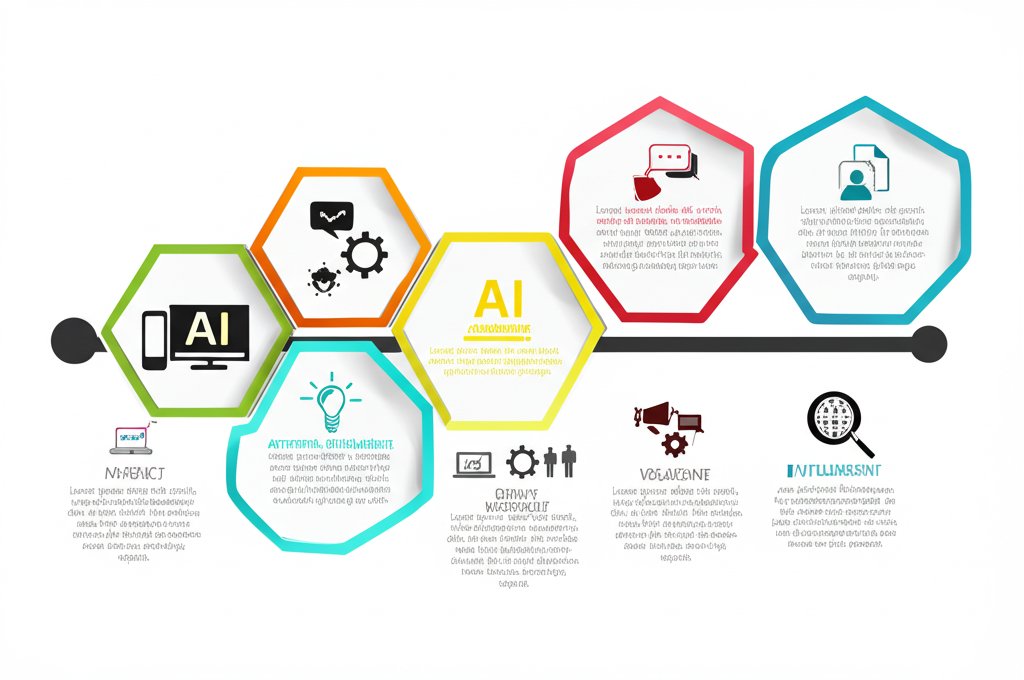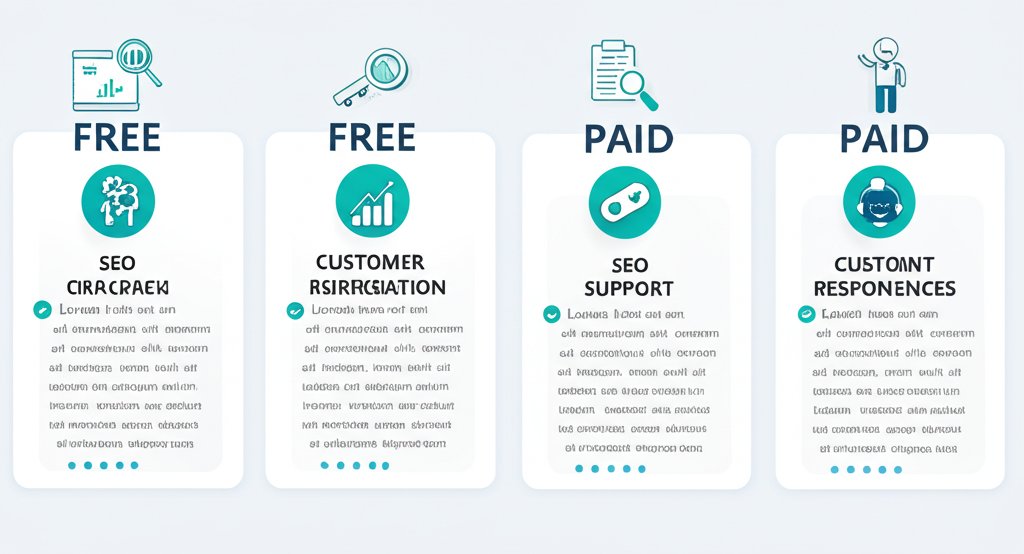Introduction to AI Generated Blog
In today's fast-paced digital landscape, businesses are constantly seeking innovative ways to enhance their content strategies. Enter the realm of AI-generated blogs—a transformative approach that leverages artificial intelligence to create compelling content quickly and efficiently. This technology is not just a trendy term; it is a revolutionary solution for companies seeking to outsource or scale their content production without sacrificing quality.
Imagine a scenario where your marketing team can focus on strategic initiatives while an AI blog writer handles the bulk of content creation. It sounds promising, doesn't it? AI-generated blogging is particularly relevant for businesses aiming to streamline operations, save time, and boost brand visibility. By harnessing the power of AI, companies can produce high-quality content at a fraction of the time and cost required by traditional methods.
Here are some key goals that AI-generated blogging helps achieve:
- Time Efficiency: AI tools can generate content rapidly, freeing up valuable time for your team to focus on other critical tasks.
- Increased Brand Visibility: With consistent and frequent content output, your brand can maintain a strong online presence, reaching a broader audience.
- Cost-Effectiveness: By reducing the need for large content teams, AI blogging tools can lower operational costs significantly.
- Enhanced Content Quality: AI-driven insights ensure that content is not only relevant but also aligns with current trends and audience preferences.
As businesses navigate the complexities of digital marketing, AI-generated blogs offer a strategic advantage, enabling them to stay ahead in a competitive market. By integrating AI into their content strategies, companies can ensure they are not just keeping up with the times but leading the charge in the future of content creation.

Understanding the Rise of AI-Generated Blogging
The journey of AI-generated blogging is a tale of technological evolution and innovation. From its early beginnings to becoming a cornerstone of modern content strategies, AI's role in blogging has been transformative. But how did we get here? Let's delve into the historical and technological milestones that have shaped AI blogging tools into what they are today.
Historical Milestones in AI Content Creation
The roots of AI in content creation can be traced back to the 1950s, when Alan Turing's groundbreaking work laid the foundation for machine intelligence. Fast forward to the 1980s, and AI began to make its mark with the emergence of machine learning, setting the stage for future applications in writing and content generation.
- The 1980s saw the introduction of spell checkers, which evolved into AI-assisted writing tools, paving the way for more advanced applications.
- 1990s: The internet boom provided a data-rich environment, crucial for AI's growth in content personalization and recommendation systems.
- 2000s: AI became mainstream, with integration into content management systems that enhanced content creation and curation.
- 2010s: The rise of deep learning and neural networks significantly improved AI's ability to generate human-like text, leading to the development of generative AI models like GPT.
- 2020s: AI-powered content creation tools have become widely accessible, offering automated solutions for content generation and optimization.
Technological Breakthroughs in AI Blogging Tools
AI blogging tools have undergone significant advancements, driven by breakthroughs in natural language processing (NLP) and machine learning. These innovations have enabled AI to not only generate coherent text but also tailor content to specific audiences and platforms.
- Natural Language Generation (NLG): This technology allows AI to create text that is contextually relevant and linguistically accurate, enhancing the quality of AI-generated blogs.
- Generative Pretrained Transformers (GPT): Models like GPT-3 have revolutionized content creation by producing text that closely mimics human writing.
- AI Blogging Tools: Platforms such as Anyword and others offer marketers the ability to generate diverse content types, from blog posts to social media updates, with ease and precision.
As AI continues to evolve, its role in content creation is set to expand further, offering even more sophisticated tools for bloggers and marketers alike. The integration of AI into blogging enhances efficiency and opens up new possibilities for creativity and engagement.
Choosing the Right AI Blog Generator for Your Needs
Choosing the right AI blog generator can significantly impact your content strategy and efficiency. But with so many options available, how do you decide which tool is the best fit for your needs? Let's explore the critical factors that can help you select the most suitable AI blog generation platform.
Key Considerations for Selecting an AI Blog Generator
When you're on the hunt for the best AI blog writer, there are several factors to consider:
- Usability: The tool should be user-friendly, allowing anyone on your team to create content without a steep learning curve. For example, platforms like LongShot AI emphasize ease of use, enabling users to produce long-form content effortlessly.
- Language Support: Ensure the AI generator supports the languages you intend to use. Some tools offer multilingual capabilities, which can be crucial for reaching a global audience.
- Customization Options: Look for tools that allow you to tailor the content to match your brand's voice and style. This feature is vital for maintaining consistency across your content.
- Integration with CMS Platforms: Seamless integration with content management systems like WordPress can streamline your workflow, allowing you to publish content directly from the AI tool.
Must-Check Features Before Deciding
Before making a decision, consider these essential features:
- SEO: Tools like BlogSpark provide intelligent keyword discovery and SEO-focused outlining to enhance search engine visibility.
- Originality Check: Ensure the tool includes plagiarism detection to maintain content integrity and credibility.
- Export Options: Flexible export options, such as direct integration with platforms or export to different file formats, can enhance your content management.
- Customer Support: Reliable support can be invaluable, especially when integrating new technology into your workflow.
By carefully evaluating these factors, you can choose an AI blog generator that meets your immediate needs and supports your long-term content strategy. Whether your goal is to optimize operations or increase content production, selecting the appropriate tool can significantly impact your success.

Comparing Free and Paid AI Blogging Platforms
In the ever-evolving landscape of content creation, selecting the right AI blogging platform can be a daunting task. With options ranging from free tools to premium solutions, understanding the differences can help you make an informed decision that aligns with your business goals. Let's break down the pros and cons of free versus paid AI blogging platforms, focusing on key aspects like cost, features, and overall return on investment.
Free AI Blog Writers: Cost-Effective but Limited
Free AI blog writers are an attractive option for startups and small businesses with tight budgets. They offer basic functionalities without any financial commitment, making them accessible to a wide audience. However, these tools often come with limitations:
- Limited Features: Free tools typically lack advanced capabilities such as SEO and extensive customization options. Such limitations can restrict the quality and scope of the content you can produce.
- Quality Concerns: The algorithms used in free platforms may not be as refined, leading to less accurate and engaging content. Users often spend additional time editing the output to meet professional standards.
- Support and Updates: Free tools generally offer minimal support and infrequent updates, which can hinder long-term productivity and adaptability to new trends.
Paid AI Blog Platforms: Advanced Features with Investment
Paid AI blogging platforms, like BlogSpark, offer a comprehensive suite of features designed to enhance content quality and efficiency. Here’s what you can expect:
- Enhanced Customization: Paid platforms provide extensive customization options, allowing you to tailor content to your brand’s voice and style, which is crucial for maintaining consistency.
- SEO Optimization: BlogSpark, an advanced tool, incorporates intelligent keyword discovery and SEO-focused outlining to optimize your content for search engines.
- Integration and Support: These platforms often integrate seamlessly with CMS systems like WordPress, offering flexible export options and robust customer support to streamline your workflow.
- Quality and Efficiency: Paid solutions use sophisticated algorithms to produce high-quality content that requires minimal editing, saving time and enhancing brand credibility.
Comparison Table: Free vs. Paid AI Blogging Platforms
| Feature | Free AI Blog Writers | Paid AI Blog Platforms (e.g., BlogSpark) |
|---|---|---|
| Cost | No cost, but feature-limited | Subscription-based, offers advanced features |
| Customization | Basic options | Extensive, brand-specific customization |
| SEO Optimization | Limited | Advanced tools for optimal SEO |
| Support | Community forums | Dedicated customer support |
| Content Quality | Basic, may need editing | High-quality, minimal editing required |
Ultimately, the choice between free and paid AI blogging platforms should be guided by your specific content needs and budget considerations. While free tools provide a cost-effective entry point, paid platforms like BlogSpark offer a robust, feature-rich solution that can significantly enhance your content strategy and ROI. By weighing these factors, businesses can select the tool that best aligns with their long-term objectives and content creation goals.
Navigating Sites That Accept AI-Driven Content
In the world of digital publishing, submitting AI-generated content to platforms or guest blogging sites requires a clear understanding of their guidelines and criteria. As AI-driven content becomes more prevalent, many sites are developing specific submission rules to ensure quality and integrity. Could you please clarify what these guidelines entail and how one might navigate them effectively?
Understanding Submission Guidelines
Before submitting AI-generated content, it's crucial to familiarize yourself with the platform's specific requirements. Here are some common guidelines you might encounter:
- Originality Checks: Platforms often require AI content to pass rigorous originality checks to prevent plagiarism. Tools like Copyscape or Grammarly's plagiarism checker are commonly used to verify content uniqueness.
- Content Style: Each platform has its own preferred style and tone. Ensure that your AI-generated content aligns with these preferences, whether it's a formal academic tone or a more conversational style.
- Disclaimers: Some sites might demand a disclaimer if they used AI in the content creation process. This transparency helps maintain trust with the audience and adheres to ethical standards.
Acceptance Criteria for AI-Driven Content
Platforms that accept AI-generated posts often have specific acceptance criteria, which can include
- Relevance and Value: The content should provide value to the readers and be relevant to the platform’s audience. AI tools should be used to enhance, not replace, the human touch in content creation.
- Accuracy and Reliability: Ensure that the AI-generated content is factually accurate and reliable. Cross-reference data and claims with credible sources to maintain content integrity.
- Ethical Use of AI: As highlighted in resources like the IEEE Author Guidelines, ethical use of AI involves proper disclosure of AI involvement in content creation and acknowledgment of the human author's contribution.
By understanding these guidelines and criteria, you can effectively navigate the landscape of AI content submission. As AI continues to evolve, staying informed about these requirements will be essential for successfully publishing AI-driven content on various platforms.
As you prepare your AI-generated content for submission, consider the next step: leveraging community spaces to boost your blog's reach and engagement.
Leveraging Community Spaces for AI-Powered Blogs
Imagine you've just published a new AI-generated blog post. What's next? How do you ensure it reaches the right audience and sparks engagement? This is where the power of online communities comes into play. By leveraging community spaces, you can significantly boost the reach and engagement of your AI-crafted content.
The Power of AI Blog Communities
Online communities are more than just platforms for discussion; they are dynamic ecosystems where like-minded individuals gather to share insights, ask questions, and build connections. For AI-generated blogs, these communities can serve as fertile ground for content promotion and audience interaction. By participating in these spaces, you can tap into a network of potential readers who are already interested in topics related to your content.
Consider platforms like Reddit, Quora, or niche-specific forums where discussions about AI and technology thrive. Engaging with these communities increases visibility and provides valuable feedback on your content. You can learn what resonates with readers and adjust your strategies accordingly.
Benefits of Community-Based Content Promotion
Promoting your AI-generated blog within online communities offers several advantages:
- Increased Reach: Communities often have thousands of active members, providing a ready-made audience for your content.
- Engagement Opportunities: By sharing your blog in these spaces, you invite comments, discussions, and questions, fostering engagement and interaction.
- Community members can provide valuable feedback and insights by highlighting areas for improvement or suggesting new topics.
- Brand Growth: Regular participation in these communities helps establish your brand as an authority in the AI space, building trust and recognition.
Popular Communities to Consider
Here are some popular online communities where AI-generated content can thrive:
- Reddit: Subreddits like r/artificial and r/MachineLearning are ideal for sharing AI-related content.
- Quora: Engage in Q&A discussions where you can link to your blog as a resourceful answer.
- LinkedIn Groups: Professional groups focused on AI and technology offer a platform for sharing insights and connecting with industry peers.
By strategically utilizing these community spaces, you can enhance the impact of your AI-generated blogs, ensuring they reach a wider audience and foster meaningful engagement. As you explore these avenues, remember that the key is to provide value and build genuine connections with your audience.
Next, let's delve into how you can maintain brand consistency while using AI to generate blog names and topics, ensuring your content aligns with your brand identity.
Building a Strong Brand with AI Name and Topic Tools
In the digital age, maintaining brand consistency is more crucial than ever. But how do you ensure that your brand's voice and identity remain uniform across all platforms? Enter AI tools designed specifically for blog branding and topic generation. These tools not only streamline the process of creating a memorable blog name but also help generate cohesive topics that align with your brand strategy.
Why Brand Consistency Matters
Brand consistency is about more than just aesthetics; it's about embodying your brand's values, voice, and identity across all content. Consistent branding helps build trust and recognition among your audience, making your brand more memorable. According to a source, generative AI is revolutionizing how brands maintain this consistency by creating content that aligns with your brand's tone and voice.
Choosing a Memorable AI-Influenced Blog Name
Think about the last time you stumbled upon a blog with a catchy name. Did it stick with you? A memorable blog name is vital for brand recall. AI tools can analyze market trends, audience preferences, and even competitor names to suggest unique and memorable blog names that resonate with your target audience. This not only saves time but also ensures that your blog name aligns with your brand's identity.
Streamlining Topic Generation with AI
Generating fresh, relevant content topics consistently can be challenging. This is where AI topic generation tools come into play. These tools leverage machine learning algorithms to analyze existing content, identify gaps, and suggest topics that are not only trending but also align with your brand's voice. For instance, tools like the AI Content Genie can provide a steady stream of content ideas, ensuring your blog remains dynamic and engaging.
- Data-Driven Insights: AI analyzes vast datasets to identify what topics are resonating with audiences, ensuring your content is both timely and relevant.
- Customization: Tailor the AI-generated topics to fit your brand's style and voice, ensuring consistency across all content.
- Efficiency: Save time on brainstorming and focus on creating high-quality content that reflects your brand's identity.
By utilizing AI tools for blog branding and topic generation, you can maintain a strong brand identity while ensuring your content remains fresh and relevant. As you continue to build your brand, remember that consistency is key, and AI can be your strategic partner in achieving this goal.

Streamlining Outlines and Visuals with AI Solutions
Imagine starting a blog post with a clear, structured outline or having the perfect image to complement your content—all within minutes. Sounds complex? Having AI at your disposal simplifies the process. AI tools have revolutionized the way bloggers approach both outlining and visual content creation, making these processes faster and more efficient.
AI-Powered Blog Outlines
Creating a compelling outline is a crucial first step in blog writing. It sets the direction and ensures your content flows logically. AI blog outline tools, like the one offered by RightBlogger, can generate detailed outlines with just a title or topic input. These tools analyze top-performing content, integrating the best practices into your outline, ensuring it is both SEO-friendly and reader-focused.
Here are some benefits of using AI for blog outlines:
- Efficiency: Quickly generate a comprehensive outline, saving time on planning.
- Consistency: Maintain a consistent structure across posts, enhancing readability.
- SEO: AI tools incorporate keywords strategically, boosting search engine visibility.
AI Image Generation: Enhancing Visual Appeal
Visuals are a powerful component of engaging content. With AI image generation tools, bloggers can create or suggest relevant images that enhance their posts without needing extensive design skills. Tools like DALL·E and others offer text-to-image capabilities, transforming simple descriptions into stunning visuals.
Consider these features of AI image generation:
- Time-Saving: Generate unique images quickly, reducing dependency on stock photos.
- Customization: Tailor visuals to fit your brand’s aesthetic, ensuring consistency across content.
- Creativity: Explore creative visual options that align with your content themes.
By integrating AI-powered tools for outlining and image generation, bloggers can streamline their content creation process, allowing more time to focus on crafting high-quality, engaging posts. As AI continues to evolve, its potential to enhance the blogging experience will only grow, offering new ways to captivate and inform audiences.
Next, we’ll explore strategies to optimize your AI-generated blogs for search visibility and audience engagement.

Optimizing Your AI-Generated Blog for Lasting Impact
When you think of AI-generated blogs, you might wonder how they can truly stand out in the crowded digital landscape. The secret lies in optimization. By refining AI-crafted drafts with a focus on search visibility, audience engagement, and conversion, you can transform them into powerful tools for your business. But how do you achieve this? Let's delve into strategies that ensure your AI-generated content reaches your target audience and resonates with them.
SEO Tweaks for Enhanced Visibility
Search engine optimization (SEO) is crucial for getting your AI-generated blogs noticed. Start by ensuring that your content aligns with the latest SEO practices. This procedure includes using relevant keywords naturally throughout your text, especially in key areas like titles, headings, and the first 100 words. Tools like SEMrush or Google Keyword Planner can assist in identifying the right keywords to target. Remember, it's not just about keyword density; it's about relevance and context. Long-tail keywords, such as "AI blog SEO" and "AI content optimization," are particularly effective as they cater to specific search intents.
Another vital aspect is to optimize meta descriptions and alt texts. These elements not only help search engines understand your content better but also improve accessibility and user experience. Additionally, consider implementing schema markup to enhance your content's visibility in search results, potentially leading to higher click-through rates.
Engaging Your Audience
Once your content is visible, the next step is to engage your audience. AI-generated content can sometimes feel impersonal, so it's important to humanize it. Incorporate storytelling elements or relatable scenarios to make your content more engaging. Ask questions like "Have you ever wondered why...?" to draw readers in and encourage interaction.
Moreover, use analytics tools to track engagement metrics such as page time, bounce rates, and social shares. These insights can guide you in refining your content strategy. For instance, if a particular topic or format is performing well, consider expanding on it in future posts.
Driving Conversions
Ultimately, the goal of your AI-generated blog should be to drive conversions. This could involve promoting newsletter sign-ups, product purchases, or any other action that aligns with your business objectives. To achieve this, include clear calls to action (CTAs) that guide readers towards the desired outcome. Ensure these CTAs are strategically placed and compelling, using action-oriented language.
Additionally, personalize your content to align with the reader's journey. By analyzing user data, AI tools can help tailor content to meet the specific needs and preferences of your audience, increasing the likelihood of conversion.
By implementing these strategies, you can optimize your AI-generated blogs for maximum impact, ensuring they not only reach but also engage and convert your target audience. As you refine your approach, remember that the key to success lies in continuous improvement and adaptation to evolving trends. Next, let's explore how to conclude your AI blogging strategy with a comprehensive overview and actionable insights.
Conclusion
As we wrap up our exploration into the world of AI-generated blogging, it's clear that this technology is not just a trend—it's a powerful tool for transforming your content strategy. Businesses ready to outsource or scale their blog services can significantly benefit from the efficiency and precision that AI brings to content creation. But why is professionally optimized, AI-driven content so crucial?
Firstly, AI blog solutions offer unparalleled time savings. By automating the content creation process, businesses can redirect their focus toward strategic initiatives and creative tasks. This shift enhances productivity and allows for a more agile response to market trends and audience needs.
Secondly, AI content support ensures consistency and quality across all posts. Tools like BlogSpark provide intelligent keyword discovery and SEO-focused outlining, ensuring each piece is structured for maximum impact. Maintaining a competitive edge in the digital landscape, where search engine rankings can significantly impact visibility, requires this level of optimization.
Moreover, AI-driven content solutions are cost-effective. By reducing the need for extensive content teams, businesses can lower operational expenses while maintaining high-quality output. This financial efficiency is particularly beneficial for startups and small businesses looking to maximize their ROI.
In conclusion, embracing AI blogging services is a strategic move for any business aiming to enhance its online presence and engage a broader audience. If you're ready to elevate your content strategy, consider integrating AI solutions like BlogSpark into your workflow. Not only will you streamline your content creation process, but you'll also ensure your brand remains at the forefront of innovation.
Take the next step in your content journey by exploring comprehensive AI blogging support. Whether you're seeking to boost organic traffic or simply speed up your content creation cycle, AI offers a cost-effective solution to elevate your blog or website.
FAQs on AI-Generated Blogging
1. Can I create a blog with AI?
Yes, AI tools can draft entire blog posts or enhance your writing. They are valuable for starting a blog and maintaining content consistency.
2. Are AI blogs legal?
AI-generated content is legal, but it must be original and ethical. Certain platforms might mandate the disclosure of AI-generated content.
3. Can Google detect AI-generated blogs?
Google can detect AI content, but it focuses on content quality. To avoid penalties, ensure your AI-generated blogs are valuable and original.
4. Which AI tool is best for blogging?
Tools like BlogSpark offer advanced features like SEO and brand voice customization, making them ideal for effective AI blogging.
5. What are the benefits of using AI for blogging?
AI blogging enhances efficiency, reduces costs, and maintains quality, allowing businesses to focus on strategic initiatives and creative work.




